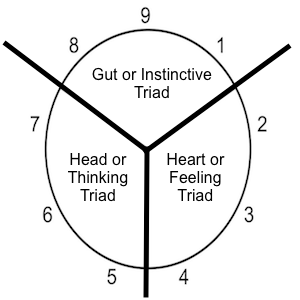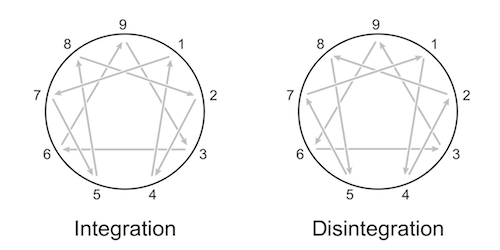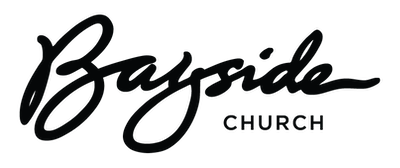(This is the second of two posts. We live in a free country, so you can go ahead with part 2. But if you don’t read Part 1, you will be lost, like middle of the desert without pantaloons or sunscreen lost.)
Before we jump into the nine virtues, let’s quickly recap:
- The Enneagram is a dynamic tool for spiritual transformation.
- The entry point to transformation is self-awareness.
- There are nine Enneagram types, each with a unique sin or passion.
- The numbers are value-neutral — larger numbers are not better than smaller ones.
- No type is inherently better or worst than any other.
- Your type develops from your childhood experiences (for more about this, click here)
Your deadly sin or passion is tied to your virtue.
Here’s the beautiful mystery of the Enneagram. Each number’s deadly sin is tied to its gift or virtue. The Enneagram confirms what Christians should already know: contentment, identity, importance and fulfillment aren’t “out there.” The abundant life is an inside-out job. Who woulda thunk it? The Enneagram gives you the insight needed to uncover your spiritual virtue and find this life.
The Enneagram says the abundant life is an inside-out job.
Real fast, here are the virtues or gifts for each Enneagram number, as well as a brief description of each when it’s healthy or mature.
The Nine Enneagram Virtues
Type 1 (Patience) — Healthy Ones practice self-compassion and live with integrity. They no longer see everything as “black and white.” They love people as they are for who they are, not who they could be.
Type 2 (Humility) — Healthy Twos are aware of their needs and don’t neglect them. They love people well and give their time, energy and resources without expecting anything in return. They establish healthy boundaries and know when to step in (and when to step back).
Type 3 (Honesty) — Healthy Threes are goal-oriented problem solvers, but they’re no longer tied to their accomplishments. They know how to balance time and energy between work and family, and they regularly make time to be rather than do.
Type 4 (Consistency or Balance) — Healthy Fours are incredibly creative and deeply attuned to beauty. Still “rangy” in terms of emotions, but much more self-aware and self-controlled, they no longer act on every emotion they feel. Healthy Fours find their uniqueness in God, so they’re much less enslaved to shame and inferiority.
Type 5 (Objectivity) — Healthy Fives see the world through the lens of abundance, not one of lack. They’re team players who willingly connect with and give to others. Healthy Fives see the whole picture through neutral eyes, balance participate and observation, and they’re comfortable sharing their findings with others.
Type 6 (Courage) — Healthy Sixes are loyal and dependable. They accept the uncertainty that is life and almost always focus their energy on the common good. In the end, they know everything will be alright.
Type 7 (Sober joy) — Healthy Sevens access the “other end” of the emotional spectrum, the parts that include grief and pain. They realize joy isn’t manufactured and there is no Resurrection without a cross. They confront the world as it is, choosing to infuse hope and joy into pain rather than avoid it.
Type 8 (Innocence) — Healthy Eights are incredible leaders who know when to take the bull by the horns and when to let the horns go. They’re ferocious defenders of the marginalized and oppressed. They’re in touch with their weaknesses and no longer fear vulnerability
Type 9 (Action) —Gifted with the ability to understand many different perspectives, healthy Nines are amazing mediators and peacemakers. They’re motivated, flexible and inclusive. They know the right thing to do, and they do it.
Wings, Intelligence Centers and Integration/Disintegration
The Enneagram will now proceed to show all the haters just how dynamic it is. You go ahead Enneagram. Do your thing.
Intelligence Centers

The Enneagram separates the nine types into three centers or triads: the Instinctive or Gut Center, the Feeling or Heart Center and the Thinking or Head Center. Each triad is driven by a particular emotion. For the Gut Triad (8,9 and 1), the emotion is anger. For the Heart Triad, it’s shame, and for the Head Triad, fear.
Let’s take myself as an example. As an Enneagram Type 9, take in and respond to life with anger. More specifically, I fall asleep to it, pretend it doesn’t exist, anything besides expressing it. My neighbor in this triad, Eights and Ones, are also controlled by anger. Eights externalize it while Ones internalize it.
Wings
If you look at a picture of the Enneagram, you notice it’s circular shape. This isn’t by accident. Every number is connected. One way the Enneagram accounts for our complexity is with wings. While one type dominates your overall personality, no one is a pure type. The numbers to the left and right of your dominant number represent your wings. Most people identify with one of the two wings (I’m a 9 with an 8 wing, for example). This wing complements your personality, and it must be taken into consideration to fully realize your true self.
Integration and Disintegration

The Enneagram accounts for the fact that humans beings aren’t static, which is fabulous because human beings aren’t static. We’re always moving and changing. Integration and Disintegration help you understand where you move in times of security and stress, respectively.
For example, as an Enneagram Type 9, I move towards the healthy side of 3 in times of growth and security. When I’m stressed, I move to the unhealthy side of 6. You get the idea? It will make more sense as you continue learning the Enneagram.
Four Points To Help You Discover Your Enneagram Number
At this point, you’re either upset that I wasted this much of your time, or you’re wondering how you discover your number.
Uncovering your Enneagram can take time. So, be patient with yourself and with the process. Here are a few pointers.
1. Start with the big picture before you focus your Enneagram number.
Your Enneagram number matters. But it’s important to see the whole picture first. In many ways you can’t fully understand your number without knowing something about every number.
Start here, with these resources.
- The Road Back to You by Ian Morgan Cron and Suzanne Stabile
- The Enneagram: A Christian Perspective by Richard Rohr
- The Sacred Enneagram by Chris Heuertz
My recommendation? Read at least two of the three books above before attempting to hone in on your number.
2. Focus on your motives, not your behaviors.
The Enneagram is so transformative because it gets to the core of things. It’s not so much focused on behaviors and much more concerned about motives.
The Enneagram is concerned with motives, not behaviors.
As you read each type and reflect on your life’s circumstances, ask “Why?” Every Enneagram type is fueled by different motives.
Both Ian Cron and Richard Rohr recommend looking at your twenty-year-old self. Why? Rohr says “At around the age of twenty, we live, as a rule, most immediately from our main energy.”
In your quest to discover your type, it might be helpful to ask “What was I like when I was twenty?”
3. The goal is TRANSFORMATION, not DISCOVERY.
I say this again, the Enneagram isn’t about flattery. It’s not a trendy personality tool or a conversation starter. The Enneagram is about spiritual transformation, becoming more like God. “Insight is cheap,” as Ian Cron says. I would add “…and dangerous.”
Discovering your true self is the most important journey you will take in this life.
Discovering your true self is the most important journey you will take in this life. It’s also the hardest. If you don’t press into God’s grace and infinite love, you will surely drown in cynicism and self-contempt.
4. Never use the Enneagram to label or fix other people.
“Now I know why my dad is domineering. He’s an immature Eight. I get it now. My spouse is clingy because she’s an unhealthy Two. Where’s my phone? I’m about to buy them a one-way ticket to the school of enlightenment.”
Just stop. Really. You deserve to be slapped.
The Enneagram is a tool for self-transformation, not another reason to label or resent people.
When you do it right, the Enneagram breaks down walls of hostility and animosity. Everyone rides the struggle bus, and there are no first-class seats.
So, this is a way too general introduction to the Enneagram. I hope and pray you see the importance of transformation and commit to discovering your true self, the man or woman God created you to be. There is no greater journey.
Grace and peace, friends.


Gloriana
Keep on writing and chgguing away!